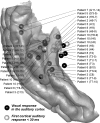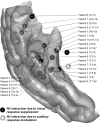Visual activation and audiovisual interactions in the auditory cortex during speech perception: intracranial recordings in humans
- PMID: 19109511
- PMCID: PMC6671467
- DOI: 10.1523/JNEUROSCI.2875-08.2008
Visual activation and audiovisual interactions in the auditory cortex during speech perception: intracranial recordings in humans
Abstract
Hemodynamic studies have shown that the auditory cortex can be activated by visual lip movements and is a site of interactions between auditory and visual speech processing. However, they provide no information about the chronology and mechanisms of these cross-modal processes. We recorded intracranial event-related potentials to auditory, visual, and bimodal speech syllables from depth electrodes implanted in the temporal lobe of 10 epileptic patients (altogether 932 contacts). We found that lip movements activate secondary auditory areas, very shortly (approximately equal to 10 ms) after the activation of the visual motion area MT/V5. After this putatively feedforward visual activation of the auditory cortex, audiovisual interactions took place in the secondary auditory cortex, from 30 ms after sound onset and before any activity in the polymodal areas. Audiovisual interactions in the auditory cortex, as estimated in a linear model, consisted both of a total suppression of the visual response to lipreading and a decrease of the auditory responses to the speech sound in the bimodal condition compared with unimodal conditions. These findings demonstrate that audiovisual speech integration does not respect the classical hierarchy from sensory-specific to associative cortical areas, but rather engages multiple cross-modal mechanisms at the first stages of nonprimary auditory cortex activation.
Figures






References
-
- Beauchamp MS, Lee KE, Argall BD, Martin A. Integration of auditory and visual information about objects in superior temporal sulcus. Neuron. 2004;41:809–823. - PubMed
-
- Bernstein LE, Auer ET, Jr, Moore JK, Ponton CW, Don M, Singh M. Visual speech perception without primary auditory cortex activation. Neuroreport. 2002;13:311–315. - PubMed
-
- Besle J, Fort A, Giard MH. Interest and validity of the additive model in electrophysiological studies of multisensory interactions. Cogn Process. 2004a;5:189–192.
-
- Blair RC, Karniski W. An alternative method for significance testing of waveform difference potentials. Psychophysiology. 1993;30:518–524. - PubMed
MeSH terms
LinkOut - more resources
Full Text Sources
